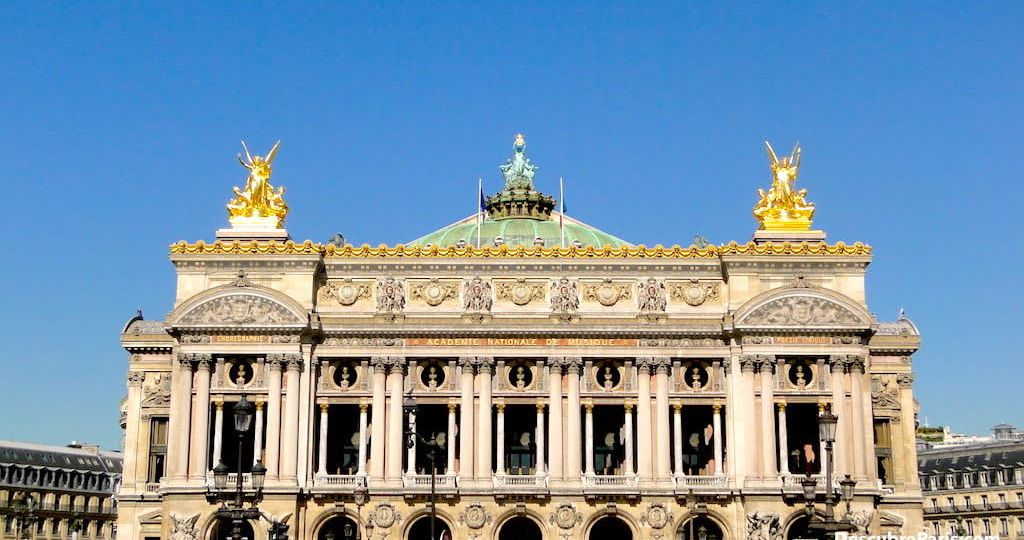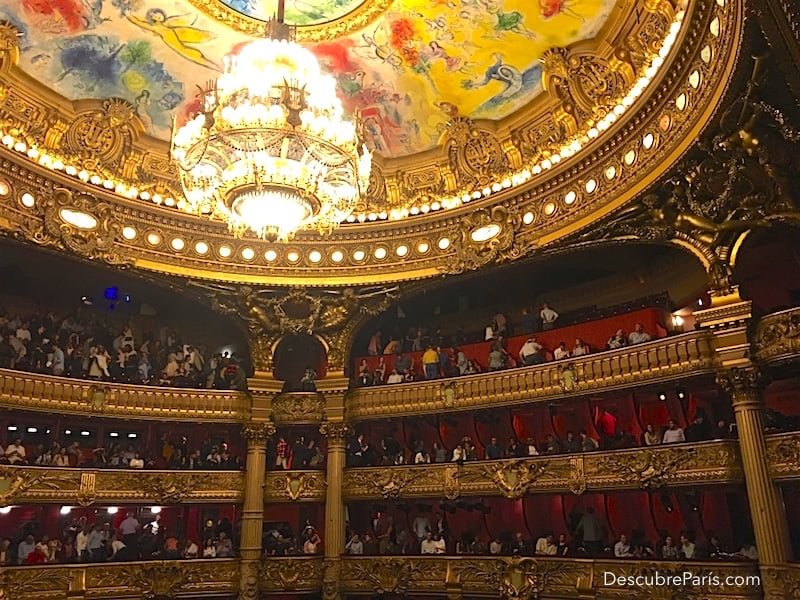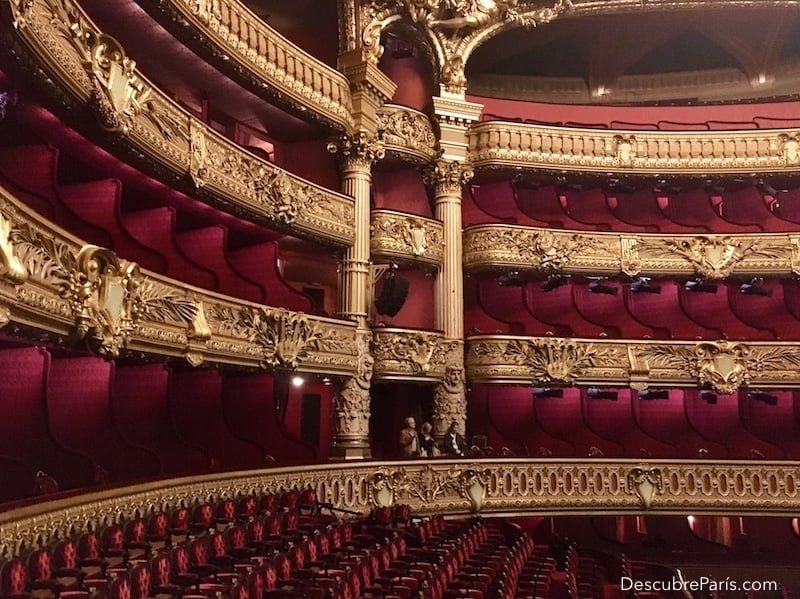
We will share with you five things you should know about the Ópera Garnier, one of the most iconic places in Paris and one of the most beautiful theaters in the world. .
The Ópera Garnier is part of the Paris Opera, which has two buildings. One of them is the Opéra Bastille, completely modern but equally important, and the other one is the Palais Garnier also known as the Ópera Garnier. In addition to the five fun facts we will share about this wonderful and surprising building, you can also find more information in our Detailed Travel Guides of three, four, and five days.
1 . The Opéra Garnier was built after an assassination attempt
En 1858, Emperor Napoleon III and his wife, Eugenia, were subject of an assassination attempt on their way to the Opéra Le Peletier. The Emperors suffered no harm, but there were many injured and dead. Napoleon III noticed that it was hard to guarantee safety measures on the narrow streets of old Paris. This is why he decided to add to the modernization project by Baron Haussmann the construction of a new opera in the newer neighborhoods in Paris. A contest was held in place to select the architect and it was won by the young Charles Garnier, who was only 35 at the time. Construction lasted 15 years and the opera was inaugurated on January 5th of 1875.
Fun Fact: Charles Garnier was practically unknown before he participated in the contest to build the Opera of Paris. He went on to win the Prix de Rome in Architecture, and was chosen in the Institut de France, in the Fine Arts Academy
2 . The Opéra Garnier has a style of its own, inspired by the past

Garnier wanted to create a style of his own. He searched for inspiration in the great works of the past, and reworked them adding color, and visual and decorative richness. The grand staircase is of classic inspiration and the abundant decoration is baroque, but Garnier added color by using marble of different shades and origins. You can also see the influence of the Sistine Chapel and the Hall of Mirrors in Versailles. Garnier merged the two architectural influences in one place by creating the impressive Grand Foyer. The ceiling was painted by Paul Baundry and it depicts themes such as the history of music.
Fun Fact: the lyre is one of the main objects present in the decoration of the room. The same lyre is held by Apollo in the high point of the theatre. Apollo is the Greek God of the arts, and in this case he is accompanied by Music and Poetry, represented by the two women on his sides.
3 . Garnier wanted to create a “theatre within the theatre”

Garnier was very aware of the kind of people that assisted to the opera. It was the rich and powerful personalities who went often. The architect took into account all details and every space was thought so that it showcased the assistants. For example, through the Pavillon des Abonnés, a circular room, he wanted the “subscribers” to feel as though they were entering a place filled with mystery and surprises. The Grand Staircase, of huge proportions and surrounded by balconies, had the purpose of allowing attendees to see and being seen. For women to parade in their dresses and feel like stars. The color of the room, for example, red and gold was selected by Garnier because he felt the reflection of the color would make the women look more beautiful.
Fun Fact: all throughout 2019 the piece Les Saturnales was on display, they were neon light circles distributed along the lower floors and giant golden wheels placed in the center of the Grand Staircase. The installation is a work by Claude Lévêque, a visual artist invited by the National Opera to celebrate its 350 years and the 30 years of the Opéra Bastille. Another thing to know about the National Opera is that its building is older than the construction of Opéra Garnier. It was Louis XIV who established the Royal Academy of Music, which preceded the National Opera and the Opéra Garnier. This is why above the curtain you can see a symbol of the Sun King.
4 .

Something that may cause a lot of surprise is that people used to go to the opera a lot more often. It was like hanging out in your house, talking and doing other things with the show as a background. Additionally, it was normal to arrive late, because the important people (supposedly) were very busy. This is why the main act (the ballet) was in the third place, to give people time to arrive. It was thanks to the influence of important characters, such as Wagner, that going to the opera took an almost religious importance, where silence was golden and punctuality expected.
Fun Fact: an opera can last between two and three hours (with two breaks), they are generally performed in Italian, French or German (with subtitles in English), and the music is played by the orquestra. In the Opéra Garnier, you can not only see operas but also ballet, concerts and recitals. Prices vary from 12€ to 160€ depending on location and type of show.
5 . The auditorium was designed for people watching

The auditorium has capacity for 2.081 people. It is shaped like a horseshoe, following Italian tradition, but it is French in its organization by category. As we mentioned before, Garnier wanted the assistants to also be part of the show which is the reason for the shape and color of the auditorium, and the placement of the chairs and boxes; of course without taking attention away from the stage.
Fun fact: the ceiling you can see today is not the original, which was damaged by the gas exuded from the gas lights. In 1960 it was replaced with artwork by Chagall, taking advantage of the low assistance to the opera during the post-war times. The inauguration of the controversial ceiling tripled assistance. The artwork recalls important artists in a symphony of colors that meant to usher in the new turn of the century.
We had to add an extra thing to our list…
6 . The Phantom of the Opera existed

At least that is what Gaston Leroux says in his fascinating book The Phantom of the Opera. This ghost is so famous that he has his own box, box number five. Leroux narrates with passion and conviction a tale of sadness and mystery that surrounds the phantom of the opera. In reality Leroux was inspired by the story of a pianist who survived the fire of the Opéra Lepeletier where his girlfriend died. It is said that the pianist took refuge in the underground lake of the Opéra Garnier until he died. All of this was used as material for Leroux´s creation, who intertwined several tragic events that actually happened in the opera (like the fall of a counterweight on top of a spectator) with an imagined character that came to life thanks to this book.
All you need to know to visit it
These are just some interesting facts about the Opéra Garnier, but the truth of the matter is that you should see this place with your own eyes. It is surprising and awe-inspiring. Do not hesitate to walk all of its corners, discover the Salón Du Glacier, the Avant-Foyer, the Foyer, Grand Foyer, and the Loggia, which is a large balcony from where you can see the Avenue de l’Opéra.
Don´t miss the Sun and Moon Auditoriums, two opposing rooms, between the Grand Staircase and the Grand Foyer. They are small, but we love their ceilings and infinity mirror.
Practical Information*:
To visit de Opéra Garnier you have to take into account if there are performances being held, if there is it is closed to the public. To know which days are open to the public you should visit the official website to choose your visiting day.
Going to a show is another way to visit the Paris Opera. On many occasions you can get tickets at a very low price (if there are seats available). Keep in mind that opera pieces can be very long.
We also suggest getting the audio-guide. It costs 5€ but it’s very worthwhile, they explain in depth all the details of the building and guide you every step of the way.
Prices:
Between 12€ and 14€ depending on if there is a performance at the time.
Audioguide: 5€
Visiting hours: between 10:00 a.m. and 4:30 p.m., except in cases of unexpected closure due to events.
Access:
Opera Stop, Lines 3, 7 and 8
Chaussée d’Antin Stop, Lines 7 and 9
Auber Stop, Line RER A
Visitor access is through one of the back corners.. First you go through a security check and then you access the ticket booth to acquire your tickets.
*All of this is just informative. Remember to always look for up-to-date information on the official Paris Opera website.
If you are coming to Paris and don’t know where to start, we can help you!
Paris is waiting for you. À bientôt.
À bientôt.

